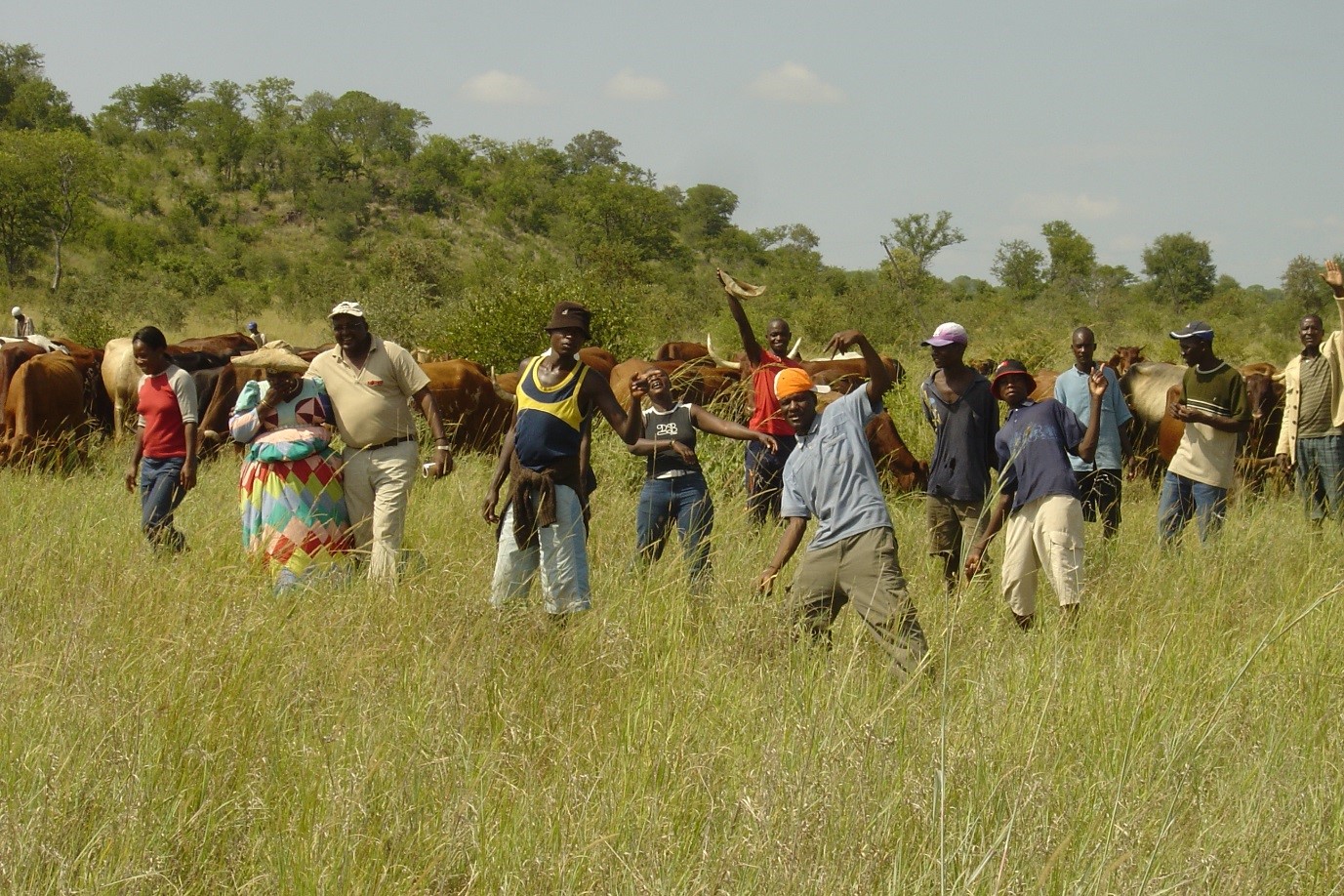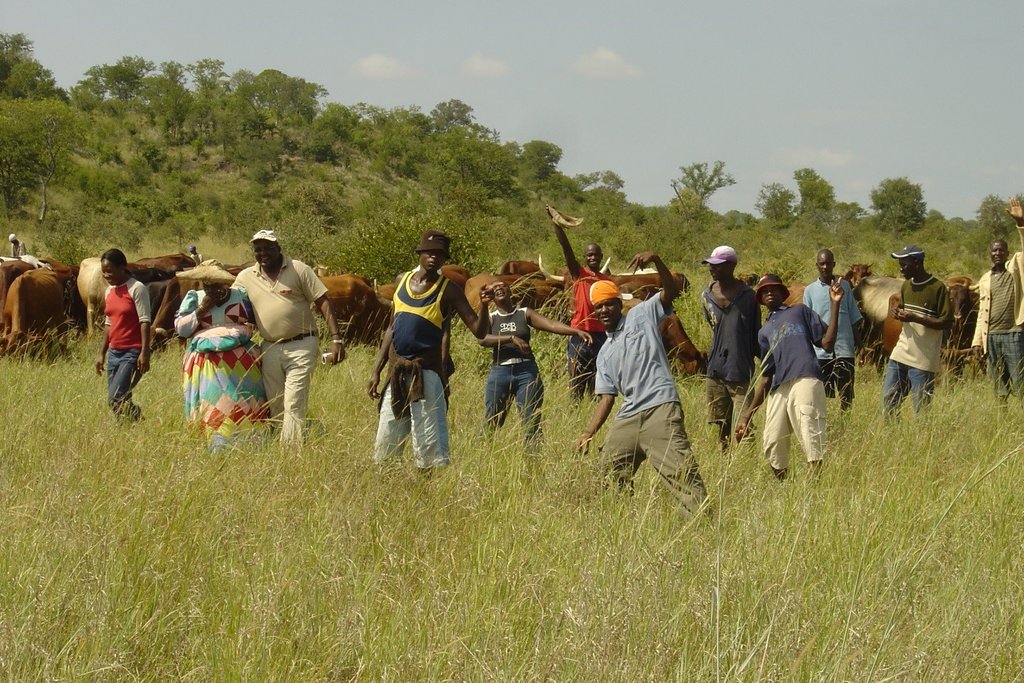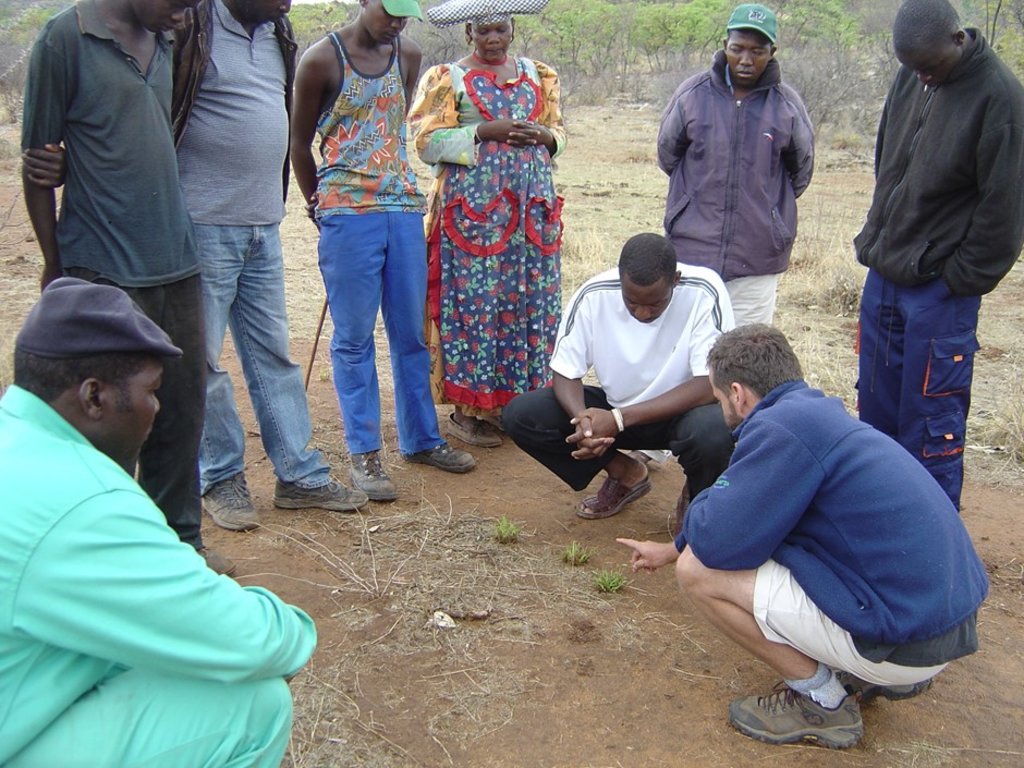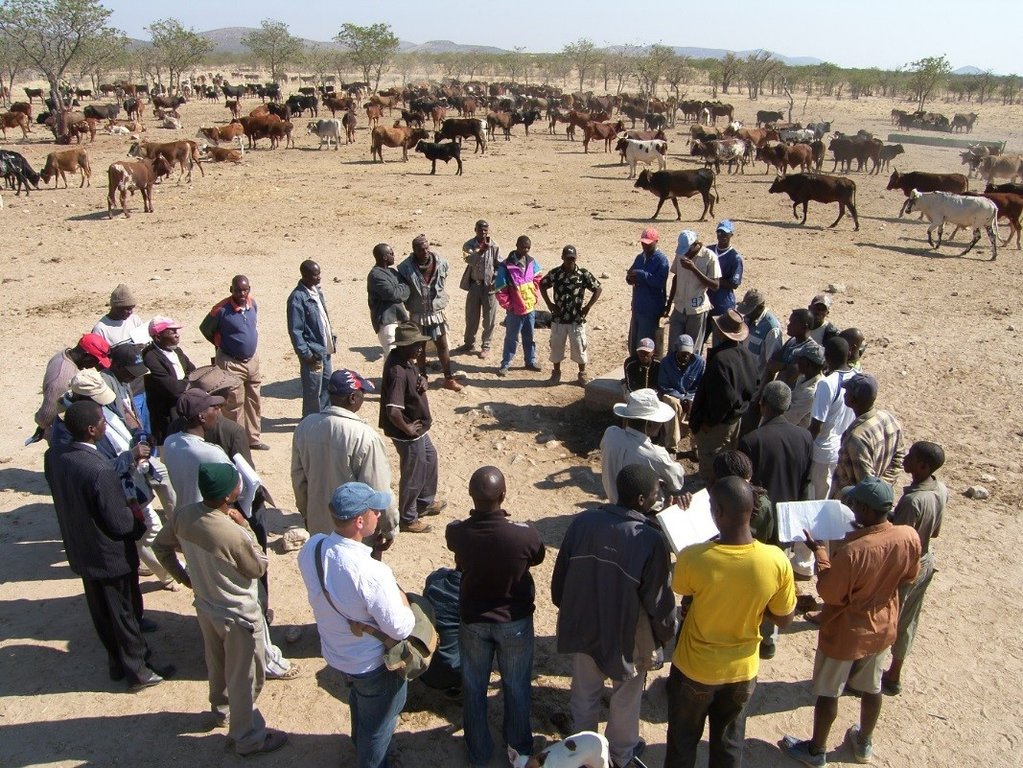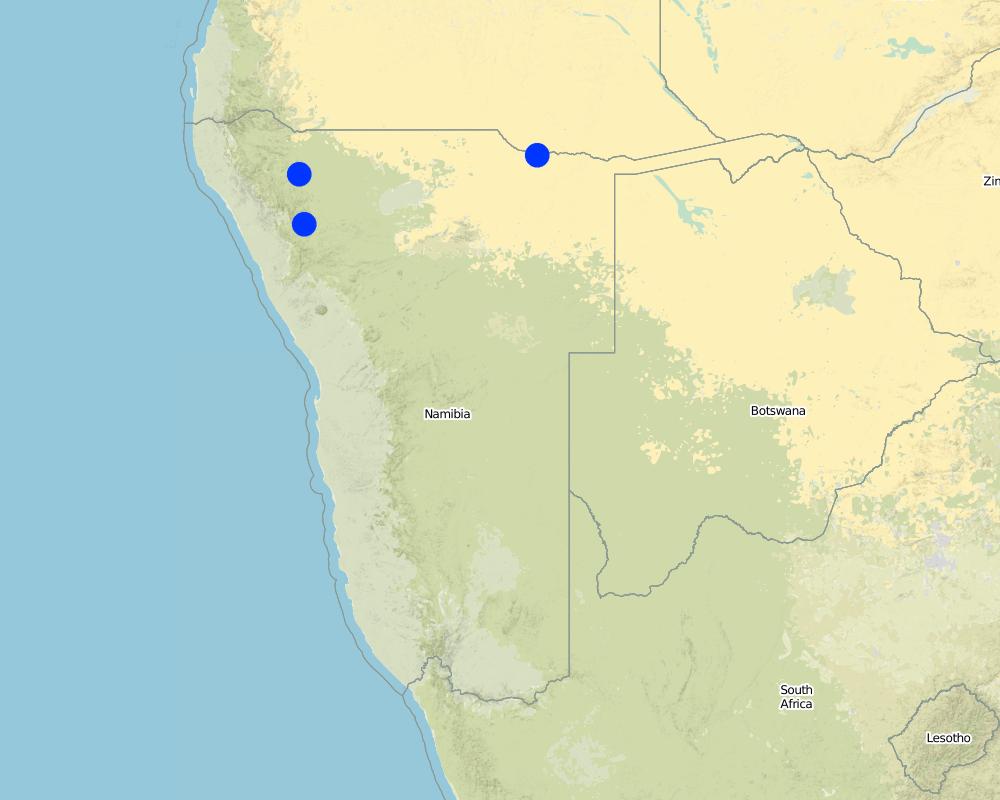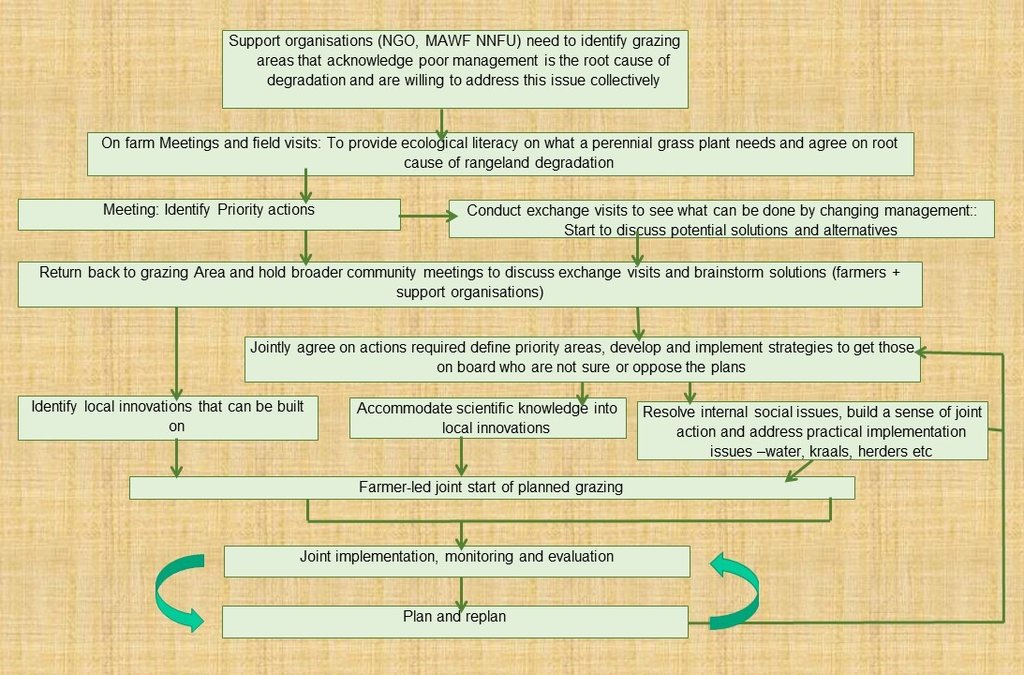Communal grazing management [ນາມິເບຍ]
- ການສ້າງ:
- ປັບປູງ:
- ຜູ້ສັງລວມຂໍ້ມູນ: Ibo Zimmermann
- ບັນນາທິການ: –
- ຜູ້ທົບທວນຄືນ: Rima Mekdaschi Studer
Omarisiro wovinamuinjo motjimbumba
approaches_3050 - ນາມິເບຍ
ເບິ່ງພາກສ່ວນ
ຂະຫຍາຍທັງໝົດ ຍຸບທັງໝົດ1. ຂໍ້ມູນທົ່ວໄປ
1.2 ລາຍລະອຽດ ການຕິດຕໍ່ ຂອງບຸກຄົນທີ່ຊັບພະຍາກອນ ແລະ ສະຖາບັນ ການມີສ່ວນຮ່ວມ ໃນການປະເມີນຜົນ ແລະ ເອກະສານ ຂອງວິທີທາງ
ຜູ້ນໍາໃຊ້ທີ່ດິນ:
ຊື່ຂອງໂຄງການ ທີ່ອໍານວຍຄວາມສະດວກ ໃນການສ້າງເອກກະສານ ຫຼື ປະເມີນດ້ານແນວທາງ (ຖ້າກ່ຽວຂ້ອງ)
Southern African Science Service Centre for climate change and Adaptive Land management (SASSCAL)ຊື່ຂອງ ສະຖາບັນການຈັດຕັ້ງ ທີ່ອໍານວຍຄວາມສະດວກ ໃນການສ້າງເອກກະສານ ຫຼື ປະເມີນແນວທາງ (ຖ້າກ່ຽວຂ້ອງ)
Conservation Agriculture Namibia (Conservation Agriculture Namibia) - ນາມິເບຍຊື່ຂອງ ສະຖາບັນການຈັດຕັ້ງ ທີ່ອໍານວຍຄວາມສະດວກ ໃນການສ້າງເອກກະສານ ຫຼື ປະເມີນແນວທາງ (ຖ້າກ່ຽວຂ້ອງ)
Zakumuka Producers Co-operative (Zakumuka Producers Co-operative) - ນາມິເບຍ1.3 ເງື່ອນໄຂ ຂອງການນໍາໃຊ້ເອກກະສານຂໍ້ມູນ ຂອງ WOCAT
ເມື່ອໃດທີ່ໄດ້ສັງລວມຂໍ້ມູນ (ຢູ່ພາກສະໜາມ)?
2017
ຜູ້ສັງລວມ ແລະ ບັນດາຜູ້ຕອບແບບສອບຖາມ ຍອມຮັບໃນເງື່ອນໄຂ ການນໍາໃຊ້ຂໍ້ມູນເອກະສານ ທີ່ສ້າງຂື້ນ ໂດຍຜ່ານ ອົງການ WOCAT:
ແມ່ນ
1.4 ເອກະສານອ້າງອີງ (ຫຼາຍ) ກັບແບບສອບຖາມ (ຫຼາຍ) ເຕັກໂນໂລຢີ ຂອງດ້ານການຄຸ້ມຄອງ ດິນແບບຍືນຍົງ
2. ພັນລະນາ ແນວທາງການຄຸ້ມຄອງນໍາໃຊ້ດິນແບບຍືນຍົງ
2.1 ການອະທິບາຍ ໂດຍຫຍໍ້ ຂອງວິທີທາງ
Facilitation of agreement among community members to jointly manage their communal grazing area by combining their livestock into a single herd to be driven to different portions of the grazing area. This is done in accordance with an agreed growing season plan that provides sufficient recovery for grazed grasses to reinvigorate themselves and a non-growing season plan to graze perennial grasses and prepare soil and plants for the upcoming growing season for regenerating rangeland productivity and well-being.
2.2 ການອະທິບາຍ ລາຍລະອຽດ ຂອງວິທີທາງ
ການອະທິບາຍ ລາຍລະອຽດ ຂອງວິທີທາງ:
The approach is a partnership between NGO, Ministries of Lands and Agriculture, National Farmers Union, traditional authorities and regional and local government. The NGO facilitates community members to recognise the damage caused to the rangeland by their individual herds of livestock grazing continuously on the same grass plants, and to appreciate the benefits that planned grazing can bring about. Farmers host facilitators on their land where the current state of the land is compared to that of the past and the reasons for the decline are investigated. Once farmers understand that all perennial grass plants need recovery and that continuous grazing depletes the root reserve, the land users soon conclude that it was their management that resulted in the loss of perennial grass and increase in bare ground. Once the root cause of the problem is established, the aim of the approach can be pursued, which is to regenerate rangeland productivity in the communal grazing area and thereby support higher production of livestock to in turn support livelihoods of the community. The focus on rangeland results from identifying and addressing the weakest link in the chain of production (converting sunlight to grass, or grass to meat, or meat to money) in a viable and upscalable manner. If motivation to apply planned grazing exists and there is sufficient cohesion among the community members, then their right to claim common property ownership of their grazing area needs to be established. In these pioneering communities this required at least 10 village level livestock owner meetings each to decide on the modalities of how to start planned grazing. These meetings continue after planned grazing has started to deal with ongoing planning as well as other aspects including animal production and marketing. Exposure visits to areas with successful grazing management helps to motivate community members. On returning home frequent follow-up meetings were facilitated by the same NGO and the Ministry of Agriculture to resolve local issues, which included overcoming traditional taboos, such as combining animals in one overnight kraal as well as whose bulls would be kept in the herd and how this would be managed. Boundaries with grazing areas of neighbouring communities need to be clearly mapped, recognised and respected by all. In case of grass poaching, the offender/s need to be swiftly and firmly dealt with, preferably through customary law. A grazing plan needs to be agreed upon by all livestock owners in the given grazing area, and endorsed by the local Traditional Authority. The Grazing Area (GA) is then mapped, while herders are appointed though agreement among all livestock owners. At night the cattle are kraaled nearby individual homesteads of their owners, where milking may take place and animals are attended to if necessary. In the morning, the appointed herders collect cattle from the different kraals (or joint kraal) and herd them to the designated portion of the grazing area for that day. Different portions of the grazing area are grazed from day to day and should not be returned to until the grazed grass has replenished its root reserves sufficiently, usually some months later. This was started at Erora in 2004, facilitated by the NGO, Integrated Rural Development and Nature Conservation (IRDNC). Implementation started in 2006, combining approximately 1200 cattle from 12 households. Farmers noticed a higher density of annual grasses after the first season, dramatic improvement in soil cover after 3 years with emergence of grass seedlings where none had grown on the hard-capped soil for decades. Then after three years, the farmers noticed the return of perennial grasses and increased biodiversity in many parts of the grazing area. However, when the extended drought started in 2011, planned grazing was interrupted and erosion gullies expanded into the grazing area, down which rainwater flowed off the landscape, thus dehydrating the rangelands. The drought lasted for five years, during which the planned grazing was temporarily discontinued in 2013. Instead, restoration work was initiated in 2014 by constructing bush filters at critical control points along key gullies, when facilitation was taken over by another NGO, Conservation Agriculture Namibia (CAN). After the region experienced successive years of severe drought and cattle in 2014 became too weak to be rounded up from all the kraals, the community members decided to revert to keeping cattle continuously near their homesteads. This had been intended as a temporary measure until surviving cattle gained sufficient strength to be rounded up from kraals and herded again, which only occurred in 2017. The communal grazing management approach was extended to other villages such as Outokototua and Nsindi in 2012, despite the drought. New boreholes were drilled and installed in all three areas to facilitate improved planned grazing.
2.3 ຮູບພາບຂອງແນວທາງ
2.4 ວີດີໂອ ຂອງວິທີທາງ
ຄວາມຄິດເຫັນ, ຄໍາອະທິບາຍຫຍໍ້:
www.youtube.com/watch?v=xNyFkDUH6MQ
This video is from a DVD created by the Integrated Rural Development and Nature Conservation (IRDNC), a Namibian NGO and co-sponsored by the Namibian Ministry of Agriculture and the Namibian National Farmers Union. The video documents the development of a rangeland program focused on Holistic Management, spearheaded by Colin Nott, a Holistic Management educator.
ວັນທີ:
2007
ສະຖານທີ່:
Erora, Namibia
ຊື່ຂອງຜູ້ຖ່າຍວີດີໂອ:
Andrew Botelle
ຄວາມຄິດເຫັນ, ຄໍາອະທິບາຍຫຍໍ້:
www.youtube.com/watch?v=3Ey5v40KtkI
Combined herding to manage communal grazing with the use of stress-free handling of cattle,
ວັນທີ:
2007
ສະຖານທີ່:
Erora, Namibia
ຊື່ຂອງຜູ້ຖ່າຍວີດີໂອ:
Andrew Botelle
ຄວາມຄິດເຫັນ, ຄໍາອະທິບາຍຫຍໍ້:
www.youtube.com/watch?v=6C4V_Cib8ts
Managing water flow to repair gully erosion
ວັນທີ:
2015
ສະຖານທີ່:
Namibia
ຊື່ຂອງຜູ້ຖ່າຍວີດີໂອ:
Andrew Botelle
2.5 ປະເທດ / ເຂດ / ສະຖານທີ່ບ່ອນທີ່ແນວທາງໄດ້ຖືກນໍາໃຊ້
ປະເທດ:
ນາມິເບຍ
ພາກພື້ນ / ລັດ / ແຂວງ:
Kunene Region
ຂໍ້ມູນເພີ່ມເຕີມຂອງສະຖານທີ່:
Erora village, 18.32637 South, 14.05912 East
Map
×2.6 ວັນທີເລີ່ມຕົ້ນ ແລະ ສິ້ນສຸດ ການຈັດຕັ້ງປະຕີບັດ ວິທີທາງ
ສະແດງປີຂອງການເລີ່ມຕົ້ນ:
2004
ຄວາມຄິດເຫັນ:
Combined herding was discontinued at Erora in 2013 due to extreme drought, which ended in 2016/2017 rainy season, and land users are planning to use reserved grazing, whereby cattle are taken out each day by herders and left there to return on their own to water points. In the meantime, combined herding has already resumed at the Outokotorua grazing area.
2.7 ປະເພດຂອງແນວທາງ
- Science informs the traditional practice
2.8 ເປົ້າໝາຍ / ຈຸດປະສົງຫຼັກ ຂອງການຈັດຕັ້ງປະຕິບັດ ວິທີທາງ
To regenerate rangeland productivity for supporting livelihoods and improved quality of life.
2.9 ເງື່ອນໄຂອໍານວຍ ຫຼື ຂັດຂວາງການປະຕິບັດຂອງເຕັກໂນໂລຢີ / ເຕັກໂນໂລຢີການນໍາໃຊ້ຕາມແນວທາງ
ສັງຄົມ / ວັດທະນະທໍາ / ມາດຕະຖານ ແລະ ຄຸນຄ່າທາງສາສະໜາ
- ອໍານວຍ
Herding is customary, and the task is now shared among families
- ເຊື່ອງຊ້ອນ
Herding no longer carries the high social status that it deserves
ມີຄວາມສາມາດ / ເຂັ້າເຖິງຊັບພະຍາກອນດ້ານການເງິນ ແລະ ການບໍລິການ
- ອໍານວຍ
No bought inputs are required, and fewer herders needed than with many small herds. Also fewer losses from stock theft and predators
ການກໍ່ຕັ້ງສະຖາບັນ
- ອໍານວຍ
A grazing area committee was established with support of livestock owners
- ເຊື່ອງຊ້ອນ
The grazing area committee is not legally recognised
ການຮ່ວມມື / ການປະສານງານຂອງຜູ້ກ່ຽວຂ້ອງ
- ອໍານວຍ
Partnership approach with Ministries of Lands and Agriculture, the Namibia National Farmers Union, traditional authorities and regional and local government
- ເຊື່ອງຊ້ອນ
Resolution of local issues to apply grazing plans needs to be resolved
ກ່ຽວກັບກົດໝາຍ (ສິດນໍາໃຊ້ດິນ, ສິດນໍາໃຊ້ນໍ້າ)
- ອໍານວຍ
National Policy and strategy is in place which supports sound management principles
- ເຊື່ອງຊ້ອນ
Grass poaching by neighbouring communities is not adequately dealt with by the law
ນະໂຍບາຍ
- ອໍານວຍ
The approach is based upon the Namibia National Rangeland Management Policy and Strategy
- ເຊື່ອງຊ້ອນ
Common property rights are insufficiently promoted
ການປົກຄອງທີ່ດິນ (ການຕັດສິນໃຈ, ການປະຕິບັດ ແລະ ຂໍ້ບັງຄັບ)
- ເຊື່ອງຊ້ອນ
Lack of integration of different scales of management between conservancies at large scales and grazing areas at smaller scale is required
ຄວາມຮູ້ກ່ຽວກັບການຄຸ້ມຄອງ ທີ່ດິນແບບຍືນຍົງ, ການເຂົ້າເຖິງການສະໜັບສະໜູນ ທາງດ້ານວິຊາການ
- ອໍານວຍ
The awareness exists among participating livestock owners and stakeholders
ຕະຫຼາດ (ໃນການຊື້ວັດຖຸດິບ, ຂາຍຜະລິດຕະພັນ) ແລະ ລາຄາ
- ອໍານວຍ
The Namibia National Farmers Union is busy addressing markets north of the veterinary cordon fence, which maintains a zone free of foot-and-mouth disease to the south from where farmers are able to access the lucrative EU market
- ເຊື່ອງຊ້ອນ
During drought the drop in prices from sudden increase in supply, results in inability of farmers to sell livestock when sudden shortage of forage occurs
ວຽກ, ມີກໍາລັງຄົນ
- ອໍານວຍ
Fewer herders are required for one large herd than for many small herds
- ເຊື່ອງຊ້ອນ
The role of herders as managers lacks status and not adequately appreciated, resulting in high turnover of trained grazing area managers and herders
ອື່ນໆ
- ເຊື່ອງຊ້ອນ
One large livestock owner at a given place can hinder efforts of the majority to improve rangeland management
3. ການມີສ່ວນຮ່ວມ ແລະ ບົດບາດຂອງພາກສ່ວນທີ່ກ່ຽວຂ້ອງທີ່ໄດ້ມີສ່ວນຮ່ວມ
3.1 ຜູ້ມີສ່ວນຮ່ວມ ໃນວິທີທາງ ແລະ ພາລະບົດບາດ ຂອງເຂົາເຈົ້າ
- ຜູ້ນໍາໃຊ້ດິນໃນທ້ອງຖິ່ນ / ຊຸມຊົນທ້ອງຖິ່ນ
Communities of Erora, Outokotorua and Nsindi
To organise, plan and implement
- ອົງການຈັດຕັ້ງ ພາຍໃນຊຸມຊົນ
Grazing Committee
Oversee day to day implementation
- ຜູ້ຊ່ຽວຊານ ການນຄຸ້ມຄອງ ທີ່ດິນແບບຍືນຍົງ / ທີ່ປຶກສາດ້ານກະສິກໍາ
Integrated Rural Development and Nature Conservation (IRDNC), then Conservation Agriculture Namibia (CAN) and Namibia National Farmers Union (NNFU)
To facilitate adoption and upscaling of the approach
- ນັກຄົ້ນຄວ້າ
United States Department of Agriculture (USDA)
To assess rangeland condition changes
- ອົງການຈັດຕັ້ງ ທີ່ບໍ່ຂື້ນກັບລັດຖະບານ
First IRDNC, then CAN
To facilitate the approach
- ພາກເອກະຊົນ
Zakumuka Producers Cooperative
To organise auctions for sale of livestock
- ອໍານາດ ການປົກຄອງທ້ອງຖິ່ນ
Traditional authorities
To support and enable agreed rules
- ພະນັກງານຂັ້ນສູນກາງ (ຜູ້ວາງແຜນ, ຜູ້ສ້າງນະໂຍບາຍ)
Namibian Ministries of Lands & Agriculture
Assist with facilitation and support
- Farmers union
Namibia National Farmers Union
Enabling policy and legislation
ຖ້າຫາກມີຫຼາຍພາກສ່ວນທີ່ເຂົ້າຮ່ວມ ໃຫ້ລະບຸ ອົງການທີ່ເປັນຫຼັກ ໃນການຈັດຕັ້ງປະຕິບັດ:
Integrated Rural Development and Nature Conservation (IRDNC), taken over in 2014 by Conservation Agriculture Namibia (CAN)
3.2 ການມີສ່ວນຮ່ວມຂອງຜູ້ນໍາໃຊ້ທີ່ດິນໃນທ້ອງຖິ່ນ / ຊຸມຊົນທ້ອງຖິ່ນໃນໄລຍະທີ່ແຕກຕ່າງກັນຂອງແນວທາງ
| ການລວບລວມ ເອົາຜູ້ນໍາໃຊ້ດິນ ໃນທ້ອງຖິ່ນ / ຊຸມຊົນທ້ອງຖິ່ນ | ໃຫ້ລະບຸ ຜູ້ໃດທີ່ມີສ່ວນຮ່ວມ ໃນແຕ່ລະກິດຈະກໍາ? | |
|---|---|---|
| ການເລີ່ມຕົ້ນ / ແຮງຈູງໃຈ | ການຮ່ວມມື | The community, with focus on livestock owners, youth, women and herders, under facilitation by NGO by conducting exchange visits to neighbouring countries |
| ການວາງແຜນ | ການຮ່ວມມື | Feedback was given to communities by participants of exchange visits, grazing committees appointed to contextualise and re-plan for the way forward under guidance of NGO, Ministry of Agriculture, Water and Forestry (MAWF) and Namibia National Farmers Union (NNFU) |
| ການປະຕິບັດ | ການຮ່ວມມື | The grazing committee, livestock owners and herders carry out the grazing plan with support of NGO, MAWF and NNFU |
| ຕິດຕາມກວດກາ / ການປະເມີນຜົນ | ການຮ່ວມມື | The grazing committee and livestock owners constantly plan and replan and evaluate results on livestock performance and rangeland and daily check where livestock have grazed and where they will graze next and feed results into re-planning. Annual assessments of forage in May, to determine stocking rate. |
| external assessment of data | ການຊ່ວຍເຫຼືອຈາກພາຍນອກ | External assessment by researchers of data gathered by USDA through Innovations for Poverty Action (IPA) |
3.3 ແຜນວາດ (ຖ້າມີ)
ການອະທິບາຍ:
Adoption of planned grazing is based on experiential learning of farmers, identification of the root cause of degradation of their rangelands, developing a vision for their future, taking decisions towards this future and solving issues jointly.
ຜູ້ຂຽນ:
Colin Nott
3.4 ການຕັດສິນໃຈກ່ຽວກັບການຄັດເລືອກເຕັກໂນໂລຢີຂອງການຄຸ້ມຄອງທີ່ດິນແບບຍືນຍົງ / ເຕັກໂນໂລຢີ
ລະບຸ ຄົນທີ່ຕັດສິນໃຈ ກ່ຽວກັບການຄັດເລືອກຂອງ ເຕັກໂນໂລຢີ / ເຕັກໂນໂລຢີ ຈະໄດ້ຮັບການປະຕິບັດ:
- ຜູ້ນໍາໃຊ້ທີ່ດິນຫຼັກ, ການສະໜັບສະໜູນ ໂດຍຜູ້ຊ່ຽວຊານ ການນໍາໃຊ້ທີ່ດິນແບບຍືນຍົງ
ອະທິບາຍ:
After exposure to sound management techniques and on farm identification and agreement on the root cause of the degradation – the farmers themselves decide if they will continue or not.
Specify on what basis decisions were made:
- ປະເມີນເອກກະສານ ຄວາມຮູ້ກ່ຽວກັບ ການຄຸ້ມຄອງ ທີ່ດິນແບບຍືນຍົງ (ຫຼັກຖານທີ່ຊ່ວຍໃນການຕັດສິນໃຈ)
- ປະສົບການສ່ວນບຸກຄົນ ແລະ ຄວາມຄິດເຫັນ (ທີ່ບໍ່ເປັນເອກກະສານ)
4. ການສະໜັບສະໜູນທາງດ້ານວິຊາການ, ການສ້າງຄວາມສາມາດ, ແລະ ການຈັດການຄວາມຮູ້.
4.1 ການສ້າງຄວາມສາມາດ / ການຝຶກອົບຮົມ
ຜູ້ນໍາໃຊ້ທີ່ດິນ ຫຼື ພາກສ່ວນກ່ຽວຂ້ອງອື່ນໆ ໄດ້ຮັບການຝຶກອົບຮົມບໍ່?
ແມ່ນ
ໃຫ້ລະບຸ ຜູ້ໃດທີ່ໄດ້ຮັບການຝຶກອົບຮົມ:
- ຜູ້ນໍາໃຊ້ດິນ
- ພະນັກງານພາກສະໜາມ / ທີ່ປຶກສາ
- Ministry of Agriculture, Namibia National Farmers Union.
ຖ້າເປັນໄປໄດ້, ໃຫ້ລະບຸເພດ, ອາຍຸ, ສະຖານະພາບ, ຊົນເຜົ່າ, ແລະ ອື່ນໆ:
Inclusion of youth, women and herders
ຮູບແບບຂອງການຝຶກອົບຮົມ:
- ການເຮັດຕົວຈິງ
- ຕົວຕໍ່ຕົວ
- ກອງປະຊຸມ
ໃນຫົວຂໍ້:
On farm(s) exploration of root cause of degradation based on how it was in the past and how it looks now and why this change has happened.
ຄວາມຄິດເຫັນ:
A number of issues including: Rangeland management, focussing on the needs of grass plants and soil. Needs of herders, people and stakeholders and how these various needs can be met. Institutional support for grazing committee, focussing on budgeting and financial management.
4.2 ການບໍລິການໃຫ້ຄໍາປຶກສາ
ເຮັດຜູ້ໃຊ້ທີ່ດິນມີການເຂົ້າເຖິງການບໍລິການໃຫ້ຄໍາປຶກສາ?
ແມ່ນ
ລະບຸວ່າການສະໜອງ ການບໍລິການ ໃຫ້ຄໍາປຶກສາ:
- ໃນພື້ນທີ່ຂອງຜູ້ນໍາໃຊ້ດິນ
- Visits to successful farmers
ອະທິບາຍ / ຄວາມຄິດເຫັນ:
Mostly through exchange visits, community meetings, on farm excursions and on-the-job training.
4.3 ສະຖາບັນການສ້າງຄວາມເຂັ້ມແຂງ (ການພັດທະນາອົງການຈັດຕັ້ງ)
ສະຖາບັນ ໄດ້ຮັບການສ້າງຕັ້ງຂື້ນ ຫຼື ໄດ້ຮັບການສ້າງຄວາມເຂັ້ມແຂງ ໂດຍການຈັດຕັ້ງປະຕິບັດ ວິທີທາງບໍ່?
- ມີ, ຫຼາຍ
ລະບຸ ທາງສະຖາບັນ ໄດ້ສ້າງຄວາມເຂັ້ມແຂງ ໃນລະດັບໃດ (ຫຼາຍ):
- ທ້ອງຖິ່ນ
- ລະດັບພາກພື້ນ
ອະທິບາຍ ສະຖາບັນການຈັດຕັ້ງ, ພາລະບົດບາດ ແລະ ໜ້າທີ່ຮັບຜິດຊອບ, ສະມາຊິກ ແລະ ອື່ນໆ.
Grazing Committee guides and implements the grazing plans and support organisations including Ministry of Agriculture, Namibia National Farmers Union and NGOs provide support and advice.
ລະບຸ ປະເພດ ຂອງສະໜັບສະໜູນ:
- ການສ້າງຄວາມອາດສາມາດ / ການຝຶກອົບຮົມ
- ອຸປະກອນ
ໃຫ້ລາຍລະອຽດເພີ່ມເຕີມ:
Exchange visits, facilitation of meetings and on-the-job training. Drilling and equipping of boreholes. Redesign of water supply for livestock and combined kraaling system.
4.4 ຕິດຕາມກວດກາ ແລະ ປະເມີນຜົນ
ການຈັດຕັ້ງປະຕິບັດ ວິທີທາງ ໄດ້ມີການປະເມີນຜົນ ແລະ ຕິດຕາມບໍ?
ແມ່ນ
ຄວາມຄິດເຫັນ:
To support decision making
ຖ້າແມ່ນ, ເອກກະສານສະບັບນີ້ ແມ່ນໄດ້ນໍາໃຊ້ເຂົ້າໃນການຕິດຕາມ ແລະ ປະເມີນຜົນບໍ່?
ບໍ່ແມ່ນ
4.5 ການຄົ້ນຄວ້າ
ນີ້້ແມ່ນສ່ວນໜຶ່ງ ການຄົ້ນຄວ້າ ຂອງວິທີທາງບໍ່?
ແມ່ນ
ລະບຸ ຫົວຂໍ້:
- ສັງຄົມ
- ເສດຖະສາດ / ການຕະຫຼາດ
- ລະບົບນິເວດ
ໃຫ້ຂໍ້ມູນ ເພີ່ມເຕີມ ແລະ ກໍານົດ ຜູ້ໃດເຮັດການຄົ້ນຄວ້າ:
USDA/IPA came to evaluate rangelands and consult key stakeholders
5. ການສະໜັບສະໜູນທາງດ້ານການເງິນ ແລະ ອຸປະກອນຈາກພາຍນອກ
5.1 ງົບປະມານປະຈໍາປີ ສໍາລັບວິທີທາງ ຂອງການຄຸ້ມຄອງ ທີ່ດິນແບບຍືນຍົງ
ສະແດງງົບປະມານ ປະຈໍາປີ ສໍາລັບອົງປະກອບ ຂອງວິທີທາງ ການຄຸ້ມຄອງ ທີ່ດິນແບບຍືນຍົງ ເປັນໂດລາສະຫະລັດ :
10000.00
ຖ້າຫາກບໍ່ຮູ້ຈັດງົບປະມານທີ່ແນ່ນອນ ແມ່ນໃຫ້ປະມານເອົາ:
- 10,000-100,000
ຄໍາເຫັນ (ຕົວຢ່າງ: ແຫຼ່ງຂໍ້ມູນຫຼັກ ຂອງການສະໜອງທຶນ / ຜູ້ໃຫ້ທຶນທີ່ສໍາຄັນ):
Major donor to initiate the project was Enagelica Entwikelins Diens (EED), through IRDNC and later funding came from the Millenium Challenge Account (MCA), the EU and now the Finnish Embassy through CAN. Cost is per grazing area for local level field facilitation.
5.2 ການສະໜັບສະໜູນ ທາງດ້ານການເງິນ / ອຸປະກອນ ສະໜອງໃຫ້ແກ່ຜູ້ນໍາທີ່ດິນ
ຜູ້ນໍາໃຊ້ດິນ ໄດ້ຮັບການສະໜັບສະໜູນ ທາງດ້ານ ການເງິນ / ອຸປະກອນ ໃນການຈັດຕັ້ງປະຕິບັດ ເຕັກໂນໂລຢີບໍ?
ແມ່ນ
ຖ້າແມ່ນ, ໃຫ້ລະບຸປະເພດ (ຫຼາຍ) ຂອງການສະໜັບສະໜູນ, ເງື່ອນໄຂ ແລະ ຜູູ້ສະໜອງ (ຫຼາຍ):
Upgrades of boreholes, drilling and equipping of new boreholes that are elephant proof and construction of lion proof kraaling was funded through the NGO.
5.3 ເງິນສົມທົບສໍາລັບການນໍາໃຊ້ສະເພາະປັດໃຈຂາເຂົ້າໃນການຜະລີດກະສິກໍາ (ລວມທັງແຮງງານ)
- ແຮງງານ
| ທີ່ຂອບເຂດ | ລະບຸ ການອຸດໜູນ |
|---|---|
| ງົບປະມານບາງສ່ວນ | Part payment to herders 2004-2007 in Erora only |
- ອື່ນໆ
| ອື່ນໆ (ລະບຸ) | ທີ່ຂອບເຂດ | ລະບຸ ການອຸດໜູນ |
|---|---|---|
| Boreholes and kraals | ງົບປະມານບາງສ່ວນ | Erora upgrade USD 10 000, second solar borehole half funded by community USD 10 000. Lion proof kraal funded by Africat – USD 2 000 |
ຖ້າແຮງງານ ຂອງຜູ້ນໍາໃຊ້ດິນ ໄດ້ຮັບການສະໜັບສະໜູນ ປັດໃຈຂາເຂົ້າ, ແມ່ນບໍ່:
- ຈ່າຍເປັນເງິນສົດ
ຄວາມຄິດເຫັນ:
Only for first four years at one of the villages to enable proof of concept to be established
5.4 ສິນເຊື່ອ
ໄດ້ປ່ອຍສິນເຊື່ອ ສະໜອງໃຫ້ພາຍໃຕ້ ວິທີການສໍາລັບກິດຈະກໍາ ການຄຸ້ມຄອງ ທີ່ດິນແບບຍືນນຍົງບໍ່?
ບໍ່ແມ່ນ
5.5 ສິ່ງຈູງໃຈ ຫຼື ເຄື່ອງມືອື່ນໆ
ການສົ່ງເສີມ ຈັດຕັ້ງປະຕິບັດ ເຕັກໂນໂລຢີ ໃນການຄຸ້ມຄອງ ດິນແບບຍືນຍົງ ໄດ້ສະໜອງສິ່ງກະຕຸກຊຸກຍູ້ບໍ່?
ບໍ່ແມ່ນ
6. ວິເຄາະຜົນກະທົບ ແລະ ສັງລວມບັນຫາ
6.1 ຜົນກະທົບຂອງແນວທາງ
ວິທີທາງ ຊ່ວຍຊຸກຍູ້ ຜູ້ນຳໃຊ້ທີ່ດິນທ້ອງຖີ່ນ, ໃນການປັບປຸງ ການມີສ່ວນຮ່ວມ ຂອງຜູ້ທີ່ກ່ຽວຂ້ອງ ບໍ່?
- ບໍ່
- ມີ, ໜ້ອຍໜຶ່ງ
- ມີ, ພໍສົມຄວນ
- ມີ, ຫຼາຍ
Through the whole approach
ການນໍາໃຊ້ ວິທີທາງ ດັ່ງກ່າວນີ້ ສາມາດເປັນຫຼັກຖານ ທີ່ສະໜັບສະໜູນ ໃຫ້ການຕັດສິນໃຈໄດ້ບໍ່?
- ບໍ່
- ມີ, ໜ້ອຍໜຶ່ງ
- ມີ, ພໍສົມຄວນ
- ມີ, ຫຼາຍ
Through observations by herders and livestock owners
ການຈັດຕັ້ງປະຕິບັດ ວິທີທາງ ສາມາດຊ່ວຍຜູ້ນໍາໃຊ້ທີ່ດິນ ໃນການຈັດຕັ້ງປະຕິບັດ ແລະ ບໍາລຸງຮັກສາ ເຕັກໂນໂລຢີ ການຄຸ້ມຄອງ ທີ່ດິນແບບຍືນຍົງໄດ້ບໍ?
- ບໍ່
- ມີ, ໜ້ອຍໜຶ່ງ
- ມີ, ພໍສົມຄວນ
- ມີ, ຫຼາຍ
Combined herding through planned grazing
ການນໍາໃຊ້ ວິທີທາງ ສາມາດປັບປຸງ ການປະສານງານ ແລະ ຄ່າໃຊ້ຈ່າຍ ການຈັດຕັ້ງປະຕິບັດ ທີ່ມີປະສິດທິພາບ ຂອງການຄຸ້ມຄອງ ທີ່ດິນແບບຍືດຍົງໄດ້ບໍ່?
- ບໍ່
- ມີ, ໜ້ອຍໜຶ່ງ
- ມີ, ພໍສົມຄວນ
- ມີ, ຫຼາຍ
Key stakeholders are all involved
ການນໍາໃຊ້ ວິທີທາງ ສາມາດລະດົມ ຫຼື ປັບປຸງ ການເຂົ້າເຖິງຊັບພະຍາກອນ ການເງິນ ສໍາລັບການຈັດຕັ້ງປະຕິບັດ ການຄຸ້ມຄອງ ທີ່ດິນແບບຍືດຍົງໄດ້ບໍ່?
- ບໍ່
- ມີ, ໜ້ອຍໜຶ່ງ
- ມີ, ພໍສົມຄວນ
- ມີ, ຫຼາຍ
ການນໍາໃຊ້ ວິທີທາງ ສາມາດປັບປຸງຄວາມຮູ້ ແລະ ຄວາມສາມາດຂອງຜູ້ນໍາໃຊ້ທີ່ດິນ ໃນການປະຕິບັດ ການຄຸ້ມຄອງ ທີ່ດິນແບບຍືດຍົງໄດ້ບໍ່?
- ບໍ່
- ມີ, ໜ້ອຍໜຶ່ງ
- ມີ, ພໍສົມຄວນ
- ມີ, ຫຼາຍ
Training provided the skills to self organise and implement activities based upon identification of root cause of land degradation
ການນໍາໃຊ້ ວິທີທາງ ສາມາດປັບປຸງຄວາມຮູ້ ແລະ ຄວາມສາມາດ ຂອງພາກສ່ວນທີ່ກ່ຽວຂ້ອງໄດ້ບໍ່?
- ບໍ່
- ມີ, ໜ້ອຍໜຶ່ງ
- ມີ, ພໍສົມຄວນ
- ມີ, ຫຼາຍ
Ministries of Agriculture and Lands
ການນໍາໃຊ້ ວິທີທາງ ສາມາດສ້າງຄວາມເຂັ້ມແຂງ ໃຫ້ສະຖາບັນການຈັດຕັ້ງ, ການຮ່ວມມື ລະຫວ່າງພາກສ່ວນທີ່ກ່ຽວຂ້ອງບໍ່?
- ບໍ່
- ມີ, ໜ້ອຍໜຶ່ງ
- ມີ, ພໍສົມຄວນ
- ມີ, ຫຼາຍ
Key stakeholders are all collaborating, since the solution to rangelands cuts across various sectors
ການນໍາໃຊ້ ວິທີທາງ ສາມາດຫຼຸດຜ່ອນ ຂໍ້ຂັດແຍ່ງໄດ້ບໍ່?
- ບໍ່
- ມີ, ໜ້ອຍໜຶ່ງ
- ມີ, ພໍສົມຄວນ
- ມີ, ຫຼາຍ
Reinstated sense of community
ການຈັດຕັ້ງປະຕິບັດ ວິທີທາງ ສາມາດສ້າງຄວາມເຂັ້ມແຂງ ທາງສັງຄົມ ແລະ ເສດຖະກິດບໍ່?
- ບໍ່
- ມີ, ໜ້ອຍໜຶ່ງ
- ມີ, ພໍສົມຄວນ
- ມີ, ຫຼາຍ
Women-headed households now have their livestock herded communally
ການຈັດຕັ້ງປະຕິບັດ ວິທີທາງ ສາມາດປັບປຸງ ຄວາມສະເໜີພາບ ຂອງບົດບາດ ຍິງຊາຍ ແລະ ສ້າງຄວາມເຂັ້ມແຂງໃຫ້ຜູ້ຍິງໄດ້ບໍ່?
- ບໍ່
- ມີ, ໜ້ອຍໜຶ່ງ
- ມີ, ພໍສົມຄວນ
- ມີ, ຫຼາຍ
Women-headed households now have their livestock herded communally
ການຈັດຕັ້ງປະຕິບັດ ວິທີທາງ ສາມາດຊຸກຍູ້ ຜູ້ນໍາໃຊ້ທີ່ດິນທີ່ເປັນຊາວໜຸ່ມ / ຄົນລຸ້ນໃໝ່ ໃນການຄຸ້ມຄອງ ທີ່ດິນແບບຍືນຍົງໄດ້ບໍ?
- ບໍ່
- ມີ, ໜ້ອຍໜຶ່ງ
- ມີ, ພໍສົມຄວນ
- ມີ, ຫຼາຍ
Herders are mainly youth and young livestock owners, who appreciate improved rangeland and are now willing to remain
ການຈັດຕັ້ງປະຕິບັດ ວິທີທາງ ສາມາດປັບປຸງ ປະເດັນການຖືຄອງທີ່ດິນ / ສິດທິໃນການນໍາໃຊ້ທີ່ດິນ ທີ່ເຊື່ອງຊ້ອນໃນການຈັດຕັ້ງປະຕິບັດ ເຕັກໂນໂລຢີ ການຄຸ້ມຄອງ ທີ່ດິນແບບຍືນຍົງໄດ້ບໍ?
- ບໍ່
- ມີ, ໜ້ອຍໜຶ່ງ
- ມີ, ພໍສົມຄວນ
- ມີ, ຫຼາຍ
The willingness to address appropriate land rights may initiate resolution of land issues
ການນໍາໃຊ້ ວິທີທາງ ໄດ້ປັບປຸງ ການຄໍ້າປະກັນສະບຽງອາຫານ ຫຼື ປັບປຸງໂຄສະນາການໄດ້ບໍ່?
- ບໍ່
- ມີ, ໜ້ອຍໜຶ່ງ
- ມີ, ພໍສົມຄວນ
- ມີ, ຫຼາຍ
Much during good rains and little during drought
ການຈັດຕັ້ງປະຕິບັດ ວິທີທາງ ສາມາດປັບປຸງ ການເຂົ້າເຖິງຕະຫຼາດໄດ້ບໍ?
- ບໍ່
- ມີ, ໜ້ອຍໜຶ່ງ
- ມີ, ພໍສົມຄວນ
- ມີ, ຫຼາຍ
ການນໍາໃຊ້ ວິທີທາງ ໄດ້ປັບປຸງ ການເຂົ້າເຖິງນໍ້າ ແລະ ສາຂາພິບານໄດ້ບໍ່?
- ບໍ່
- ມີ, ໜ້ອຍໜຶ່ງ
- ມີ, ພໍສົມຄວນ
- ມີ, ຫຼາຍ
Access to borehole water was provided
ການນໍາໃຊ້ ວິທີທາງ ໄດ້ປັບປຸງ ການນໍາໃຊ້ແຫຼ່ງພະລັງງານ ແບບຍືນຍົງຫຼາຍຂື້ນບໍ່?
- ບໍ່
- ມີ, ໜ້ອຍໜຶ່ງ
- ມີ, ພໍສົມຄວນ
- ມີ, ຫຼາຍ
Solar installations were installed or replaced diesel where possible for pumping of water
ການຈັດຕັ້ງປະຕິບັດ ວິທີທາງ ສາມາດສ້າງຄວາມອາດສາມາດໃຫ້ຜູ້ນໍາໃຊ້ດິນ ໃນການປັບຕົວ ຕໍ່ການປ່ຽນແປງດິນຟ້າອາກາດ / ຫຼດຜ່ອນຄວາມສ່ຽງທາງໄພພິບັດໄດ້ບໍ? :
- ບໍ່
- ມີ, ໜ້ອຍໜຶ່ງ
- ມີ, ພໍສົມຄວນ
- ມີ, ຫຼາຍ
Improved grass growth in good rain years and improved survival in drought
ການນໍາໃຊ້ ວິທີທາງ ໄດ້ປັບປຸງ ການຈ້າງງານ, ໂອກາດ ໃນການສ້າງລາຍຮັບບໍ່?
- ບໍ່
- ມີ, ໜ້ອຍໜຶ່ງ
- ມີ, ພໍສົມຄວນ
- ມີ, ຫຼາຍ
Herders and managers were appointed
6.2 ແຮງຈູງໃຈຫຼັກຂອງຜູ້ນໍາໃຊ້ທີ່ດິນໃນການປະຕິບັດການຄຸ້ມຄອງທີ່ດິນແບບຍືນຍົງ
- ການຜະລິດເພີ່ມຂຶ້ນ
Increased grass, higher calving and reduced mortalities
- ກໍາໄລເພີ່ມຂຶ້ນ (ຄວາມສາມາດ), ການປັບປຸງຄ່າໃຊ້ຈ່າຍ, ຜົນປະໂຫຍດ, ອັດຕາສ່ວນ
Increased grass, higher calving and reduced mortalities
- ຫຼຸດຜ່ອນດິນເຊື່ອມໂຊມ
Changing unsustainable practices for improved resource base
- ການຫຼຸດຜ່ອນພາລະວຽກ
Fewer herders needed
- ກຽດສັກສີ, ຄວາມກົດດັນທາງສັງຄົມ / ການຕິດຕໍ່ກັນທາງສັງຄົມ
Social cohesion to implement joint management
- ຄວາມຮັບຮູ້ ທາງສີ່ງແວດລ້ອມ
To support the future of livestock in their area
6.3 ຄວາມຍືນຍົງຂອງກິດຈະກໍາວິທີທາງ
ຜູ້ນໍາໃຊ້ ທີ່ດິນ ສາມາດສືບຕໍ່ ການຈັດຕັ້ງປະຕິບັດ ຜ່ານວິທີທາງໄດ້ບໍ່ (ໂດຍປາດສະຈາກ ການຊ່ວຍເຫຼືອ ຈາກພາກສ່ວນພາຍນອກ)?
- ແມ່ນ
ຖ້າ ໄດ້, ອະທິບາຍເຫດຜົນ:
They mobilise themselves, appoint herders, do the implementation, do the planning jointly and, and only asking for some technical support
6.4 ຈຸດແຂງ / ຂໍ້ດີ ຂອງວິທີທາງ
| ຈຸດແຂງ / ຂໍ້ດີ / ໂອກາດໃນການນໍາໃຊ້ທີ່ດິນ |
|---|
| By caring for the rangeland, farmers will have grass all year round and minimise effects of drought |
| ຈຸດແຂງ / ຈຸດດີ / ໂອກາດ ຈາກທັດສະນະຂອງຜູ້ປ້ອນຂໍ້ມູນ ຫຼື ບຸກຄົນສຳຄັນ |
|---|
| It has proven to improve the resource base if applied properly |
| It is viable and upscalable |
| It has diverse benefits for the land user, including economic, social and environmental |
6.5 ຈຸດອ່ອນ / ຂໍ້ເສຍຂອງແນວທາງ ແລະ ວິທີການແກ້ໄຂໃຫ້ເຂົາເຈົ້າ
| ຈຸດອ່ອນ / ຂໍ້ເສຍ / ຄວາມສ່ຽງໃນມູມມອງຂອງຜູ້ນໍາໃຊ້ທີ່ດິນ | ມີວິທີການແກ້ໄຂຄືແນວໃດ? |
|---|---|
| If a new water point needs to be developed, then funds will be required | Convince land users that by selling one or a few cattle to invest in a new water point, they will realise the returns from increased productivity within a few years |
| ຈຸດອ່ອນ ຫຼື ຂໍ້ເສຍ ຫຼື ຄວາມສ່ຽງ ໃນມຸມມອງຂອງ ຜູ້ສັງລວມຂໍ້ມູນ ຫຼື ບັນດາຜູ້ຕອບແບບສອບຖາມ | ມີວິທີການແກ້ໄຂຄືແນວໃດ? |
|---|---|
| The herding is hard work, the status of herders is perceived to be low and they are poorly compensated. |
Convince livestock owners that they can adequately afford to compensate the herders. Start national and regional vocational training in herding, grazing management, low-stress handling, animal health, rangeland management, water management and financial and farm management |
7. ເອກກະສານອ້າງອີງ ແລະ ຂໍ້ມູນການເຊື່ອມໂຍງ
7.1 ວິທີການ / ແຫຼ່ງຂໍ້ມູນ
- ການໄປຢ້ຽມຢາມພາກສະໜາມ, ການສໍາຫຼວດພາກສະໜາມ
- ການສໍາພາດ ຜູ້ນໍາໃຊ້ທີ່ດິນ
- ສໍາພາດ ຊ່ຽວຊານ ການຄຸ້ມຄອງ ດິນແບບຍືນຍົງ
7.2 ເອກະສານທົ່ວໄປທີ່ສາມາດໃຊ້ໄດ້
ຫົວຂໍ້, ຜູ້ຂຽນ, ປີ, ISBN:
Global case studies of grazing in nature’s image, Jim Howell, 2008, 1-4392-1610-X
ມີຢູ່ໃສ?ມູນຄ່າເທົ່າໃດ?
www.booksuge.com
7.3 ການເຊື່ອມຕໍ່ກັບຂໍ້ມູນທີ່ກ່ຽວຂ້ອງທີ່ສາມາດໃຊ້ອອນໄລນ໌
ຫົວຂໍ້ / ພັນລະນາ:
Community based rangeland and livestock management
URL:
https://rmportal.net/groups/cbrlm/cbrlm-for-review/namibia-community-based-rangeland-livestock-management-cbrlm-2nd-edition/view
ຂໍ້ມູນການເຊື່ອມຕໍ່ ແລະ ເນື້ອໃນ
ຂະຫຍາຍທັງໝົດ ຍຸບທັງໝົດການເຊື່ອມຕໍ່
ບໍ່ມີຂໍ້ມູນການເຊື່ອມຕໍ່
ເນື້ອໃນ
ບໍ່ມີເນື້ອໃນ


